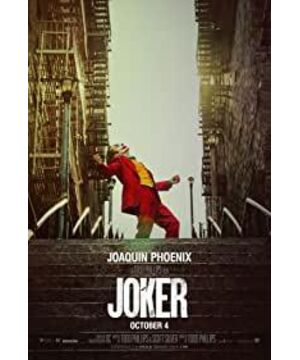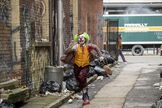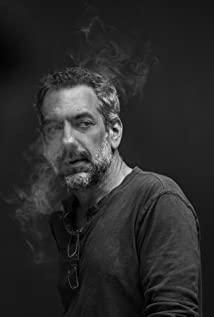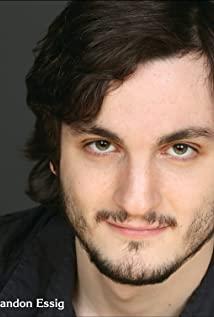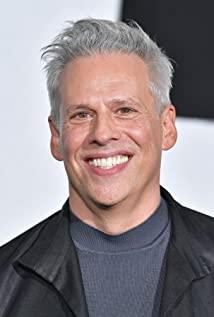Zhou Chuanji believes that "the signifier and the signified of the image are short-circuited." I think Mr. Zhou should explain it from the perspective of literal semiology. It seems that the "coexistence" of the image does make the "significant" and "significant" inside the image appear at the same time, which is different from the gap between the signifier and the signified in literal semiotics. In my opinion, what Mr. Zhou finally pointed out was the fundamental difference between the language of words and the language of images. The "coexistence" of images has actually changed the basis of image language. In other words, the momentary presentation of the image actually brings only the "significant", and does not bring out the connotation of the "referred". For the image, the appearance of the referent requires montage, or image and text, and The result of sound mixing ideology.
For example, if the sentence "there is a loquat tree in the courtyard, and the pavilion is like a building" is understood by textual semiology, the signifier and the signifier have been clearly displayed, and the text evokes the image in the brain based on personal experience. But what if this is an image? What we see is a conclusive image. What it cancels first is the participation of private experience, and the presentation of the image does not bring any signification, but the image itself. (As suggested by your neighbor Zhang Wuman) What is actually presented here is a certain kind of "emptiness": the signification brought by a quintessential signifier is in vain. In the face of the "emptiness" of this image, the audience's consciousness has also gained relative freedom based on the image itself. Because this image does not bring conclusive information transmission order. So this can only be equal to the "morpheme" or "phoneme" in literal semiotics.
The "emptiness" brought about by the image may be understood in terms of Aristotle's "scarcity". Aristotle believes that "scarcity" will bring about a trend movement (the full part flows to the empty part), which may be It's a bit absolute, but the "emptiness" brought by the image at least provides space for the audience's consciousness to flow, and it provides a certain "relaxation". If the "relaxation" of this language is handled well, it will form a certain spatial illusion, which will bring a sense of "presence" to the audience.
And if it is an image showing a pavilion-like loquat tree, coupled with the words "planted by my wife in the year of death", or directly using images to present two situations, through the docking of the two situations, it will bring you It is precisely the narrative pointing to a certain degree, a certain absolute order. That is to say, to this extent, the signifier and the signified of the image language have been docked, resulting in a clear ideogram, the language has entered order, and this language is "full" (not lost). In my opinion, for the image, the collision of multiple situations brings about the conclusive narrative, even if the narrative direction is unspeakable (such as the "words" suggested by Godard).
The whole of "Joker", in my opinion, provides the "full" feeling of language. To some extent, it cancels the autonomy of the audience's consciousness. The following is a glimpse of the leopard through the opening pull tab.
The narrative is conclusive, and the "fullness" of the language is my overall feeling of the whole film of "Joker". The film does not provide language "emptiness" (space), and the whole is presented as an absolute order of "fullness". Of course, it is undeniable that if there is no such absolute language order in a script like "Joker" based on the feeling of realism, it would be difficult to avoid flaws, and flaws are actually very easy to respond to social moral problems and cause uncontrollable problems. situation. So for the film strategy, this seems to be an inevitable. This is completely different from Nolan's "Dark Knight" such a typified film, the genre film brings the abstraction of the situation, it is difficult for the audience to equate the genre film with reality. Therefore, the horizontal comparison between "Joker" and "The Dark Knight", no matter what standard it comes from, it seems to me to be unbiased. The realism of "Joker" can only be controlled through absolute language control. Based on the sensitivity of the object being processed, the film has a "cautious" basis.
The absoluteness of this language order, to some extent, actually cancels the space for the audience’s autonomous consciousness. Therefore, during the movie watching process, I always felt that I was not completely surrounded by the situation, so that I wondered if it would be better if it was a big screen. point? But it is obvious that this problem does not exist for excellent films in the usual sense. This is one of the reasons why I don't like this film very much, but it does not deny the excellent image language itself.
Although most of the information in the movie is "full" in an orderly manner. But there are exceptions, such as the scene where Arthur goes to the mental hospital. This is my favorite in the whole film. I think it provides a model of visual language narrative. Before going to the mental hospital, the overall performance of the film was the struggle between the normal personality and the clown personality in Arthur's body. In other words, according to Zizek, Arthur did not fully recognize the clown in his body (in the mirror image). Arthur came to the mental hospital with doubts as to whether his mother was really a schizophrenic. According to the narrative rhythm, the clown personality is not fully revealed at this time, but the film directly presents an "externalization of the clown personality"-an extremely horrible mental hospital space. The creation of this spatial situation seems to directly surpass the previous anxious state of the normal personality and the clown personality in Arthur's body, presenting an independent and complete situation itself, this situation is slightly broken to the overall rhythm of the film, according to the above view , I think this independent scene is actually embodied as a pure "signifier suspension", a "failure" of the image language, and the situation does not have a clear "referential" direction at this time.
Immediately after Arthur’s chat with the archivist, he suddenly mentioned abnormally that he had killed three people a few days ago. If you understand the rhythm of the previous film, here is another sense of relief: Arthur is obviously It's straight into the clown-like situation-the words begin to "excessive". We might as well understand that in the horror situation of the mental hospital-the absolute externalization of the clown's crazy personality, Arthur suddenly entered the clown-like discourse style. This is a perfect span: to provide a clown-like personality externalization through audio-visual, the audio-visual situation suddenly changed Arthur's attributes, so that he directly "leaped" into the clown personality. That is to say, here, there is a certain span between the signifier and the signified of the image language, and there is a big gap. This "gap" brings a short-term "emptiness", which can envelop/accommodate the consciousness of the audience.
Throughout the film, the complete presentation of the crazy situation of this mental hospital also brings Arthur's absolute recognition of the personality of the clown. Then he began to go into madness. That is to say, as a play, this situation is the "turn" of the "transition", providing a "narrative point". And this sharp point of narrative is done by popping up "empty" from the "full" of the overall language.
The "tight"/"full" order of the overall language of "Joker" is obviously a double-edged sword. However, considering the possibility of the film inducing social moral accusations, I am afraid that absolute control of language is a last resort strategy. In order to resist the shortcomings caused by this "fullness", the film also provides another coping strategy-"virtual" and "real". What needs to be reminded is that the control of "virtual" and "real" is also accomplished through the control of language order.
"Void" can also provide the audience with a space for the flow of consciousness, only through the absolute control of the language of the image, this kind of consciousness flow is grasped as a "path flow" to control the unexpected flow of consciousness. Two "virtual" strategies have been developed for this film. One is to deliberately handle the question of whether Arthur is Wayne’s own ambiguity; the other is to provide thinking about whether the story shown in the film is actually happening, just like the film All the clocks in the film stayed at 11:11 (fixed time) for psychological consultation, and the two psychological consultations at the beginning and the end of the film were actually in the same space (fixed space). The film hopes to arouse double doubts through time and space (isn't this the foundation of the film? Time-space) to cancel the audience's perception of the film's current reality. In order to weaken the film's impact on the audience's real space. As for whether Arthur Wayne’s own blurry treatment, it also leads the viewer's consciousness to the past (what happened?) and the future (the war between the Joker and Batman, why does the Joker know Batman so much?) Really cancel the present.
In my opinion, telling the story of a schizophrenic person through the absolute order of image language always carries the original sin. Ordering brings logic, while schizophrenia brings about cancellation logic. Just as the stairs in the movie above symbolize Arthur's persistence in life, going down the stairs symbolizes complete indulgent clown madness. It is also reflected in the order of upper and lower. This is my second doubt about the film. Of course, I have already answered this doubt as mentioned above.
"Joker" is by no means a bad film, in fact it is a real "movie". It's just that scoring is usually very personal, based on the narrowness of the individual's personal experience.
View more about Joker reviews


